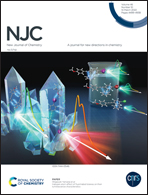A novel triruthenium nitrosyl bearing a quinolinic ligand: a comparison of its spectroscopic behavior with its pyridine analogues†
Abstract
We present the novel compound [Ru3O(CH3COO)6(iq)2NO]PF6, iq = isoquinoline. Its electronic spectrum displays three charge-transfer bands between 350 and 550 nm and a band due to intra-cluster transitions centered at metallic levels at 701 nm (842 L mol−1 cm−1). This compound releases NO(g) under UV irradiation (λirrad = 365 nm), with ϕ = 0.23 in acetonitrile solution. Its 1H NMR spectrum shows attenuated paramagnetic anisotropy of the [Ru3O] unit. As for IR spectroscopy, the ν(NO) stretching band (1904 cm−1) arises at a relatively high frequency, suggesting that the NO ligand has important NO+ character. To understand the nature of the [Ru3O]–NO metallic core, we have compared the spectroscopic data of [Ru3O(CH3COO)6(iq)2NO]PF6 with the data of pyridinic analogues bearing 4-acetylpyridine, 3-methylpyridine, pyridine, 4-methylpyridine, or 4-tert-butylpyridine as ancillary ligands. Except for the value of ν(NO), the introduction of a ligand (iq) bearing a second aromatic ring does not impact the other spectroscopic properties of the metallic core. The nitrosyl compounds with the general formula [Ru3O(CH3COO)6(L)2NO]PF6 share similarities with both symmetric compounds ([RuIIIRuIIIRuIIIO(CH3COO)6(L)3]PF6) and with the isoelectronic carbonyl compounds ([RuIIIRuIIIRuIIO(CH3COO)6(L)2CO]) and there is no clear evidence for the role of π-backbonding in their spectroscopic characteristics. These findings point to the presence of two metallic subunits: a {RuNO}6 portion with high covalence and electron pairing, and thus less sensitivity to variations in L; and a second subunit, Ru2III,III, which is susceptible to perturbations to its electronic density by σ-donation from L. This analysis finally suggests that the triruthenium nitrosyl compounds constitute multiconfigurational systems with relevant contributions from both RuIIIRuIIIRuIII–NO0 and RuIIIRuIIIRuII–NO+ configurations.



 Please wait while we load your content...
Please wait while we load your content...